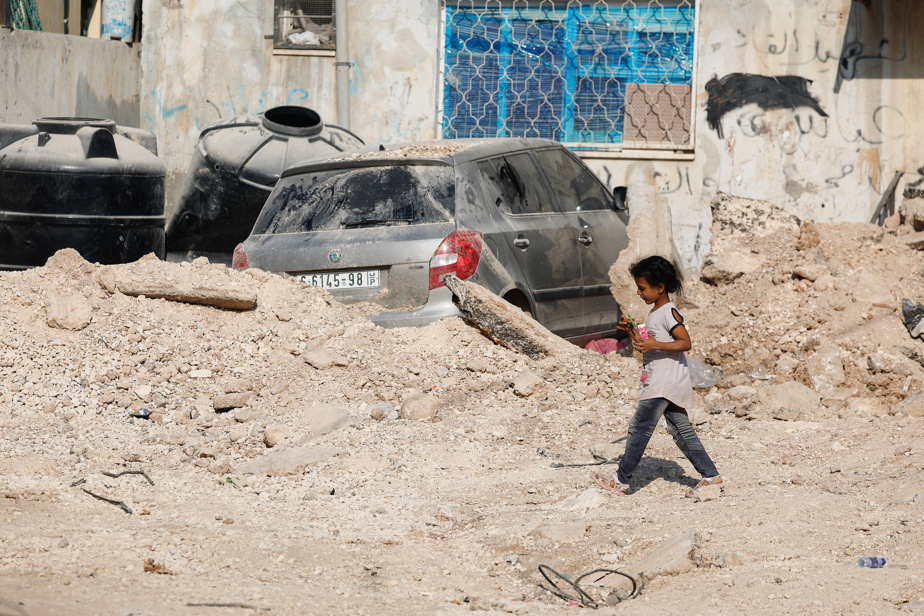(Jenin) The Israeli army withdrew Friday from the city of Jenin after a vast “anti-terrorist” operation in the occupied West Bank, continuing its offensive in the Gaza Strip, after almost eleven months of war with the Palestinian Islamist movement Hamas.
The United States on Thursday urged Israel and Hamas to finalize a ceasefire deal in Gaza, as both sides accused each other of derailing the negotiations.
During a visit to Israel, German Foreign Minister Annalena Baerbock also called on Friday for a “ceasefire now,” saying that “the pure military approach” offered no solution to the war.
The war in Gaza, triggered by an unprecedented Hamas attack on Israel on October 7, has left tens of thousands dead and caused enormous destruction and a humanitarian catastrophe in the Palestinian territory, home to 2.4 million people.
Vast destruction
Since October 7, violence has flared up in the West Bank, and on August 28 the army launched a vast “anti-terrorist” operation in the north of this territory occupied by Israel since 1967, where armed groups fighting against Israel are particularly active.
The raids, which are regular in the occupied West Bank but have rarely reached such a scale, have focused on Jenin and its surroundings, and have been accompanied by significant destruction according to witnesses and AFP journalists.
According to residents, Israeli soldiers withdrew from Jenin and its refugee camp overnight.
“To date, 14 terrorists have been eliminated, more than 30 suspects have been arrested” in Jenin, the Israeli army said in a statement on Friday, without announcing the end of its operation.

PHOTO ISMAEL KHADER, REUTERS
Jenin, September 5
According to the Palestinian Authority Health Ministry, a total of 36 Palestinians aged 13 to 82 have been killed by the Israeli army in the northern West Bank since August 28. The army announced that one of its soldiers was killed in combat in Jenin on August 31.
Israeli Foreign Minister Israel Katz told M on Fridayme Baerbock that Iran’s supreme leader, Ayatollah Khamenei, wanted to “arm Judea and Samaria (the West Bank, editor’s note) like Gaza.”
At the same time, the Israeli army continued its offensive in the Gaza Strip, where the Civil Defense reported injuries in the Israeli bombing of a house in Bureij, in the center of the territory.
“Blind bias”
The Hamas attack on October 7 resulted in the deaths of 1,205 people on the Israeli side, mostly civilians, according to an AFP count based on official data. Of the 251 people kidnapped that day, 97 are still being held in Gaza, 33 of whom have been declared dead by the army.
The Israeli operations, which have caused a humanitarian and health catastrophe in the besieged Gaza Strip, have left 40,878 dead there, according to the Gaza government’s Health Ministry, which does not provide details on the number of civilians and fighters killed. The majority of the dead are women and children, according to the UN.

PHOTO RAMADAN ABED, REUTERS
A displaced woman, Iqbal Al-Zeidi, stands in front of her tent which was destroyed by an Israeli strike, in the courtyard of Al-Aqsa Martyrs Hospital.
Along with Qatar and Egypt, the United States, Israel’s main ally, has been mediating for months to convince the two sides to reach an agreement.
US Secretary of State Antony Blinken confirmed US assessments that 90% of the deal was ready.
“It is really up to both sides to reach an agreement on the remaining issues,” he told a news conference.
For his part, Khalil al-Haya, a member of Hamas’s political bureau based in Qatar, said that if the United States “really” wanted to achieve a ceasefire, it had to “abandon its blind bias for the Zionist occupation and exert real pressure on Netanyahu.”
Netanyahu inflexible
Since the announcement on Sunday of the discovery in Gaza of the bodies of six Israeli hostages, killed at “point-blank range” by Hamas according to the Israeli army, Mr Netanyahu has been under strong pressure to reach an agreement allowing the release of the hostages.

PHOTO FLORION GOGA, REUTERS
Demonstrators in support of the hostages in the streets of Tel Aviv
But the prime minister remains inflexible, having vowed to destroy Hamas, which seized power in Gaza in 2007 and is considered a terrorist movement by the United States and the European Union.
Among the sticking points for a deal is Mr. Netanyahu’s desire to maintain Israeli control over the Philadelphia Corridor, a buffer zone along the Gaza-Egypt border, to prevent Hamas from smuggling weapons into the Palestinian territory or exfiltrating hostages or some of its fighters through tunnels to Egypt.
“There is no agreement being negotiated,” Netanyahu told Fox News.
Hamas insists on implementing as is a plan announced on May 31 by US President Joe Biden, which provides for a six-week truce accompanied by a partial Israeli withdrawal and the release of hostages, then eventually a total Israeli withdrawal from the territory.
